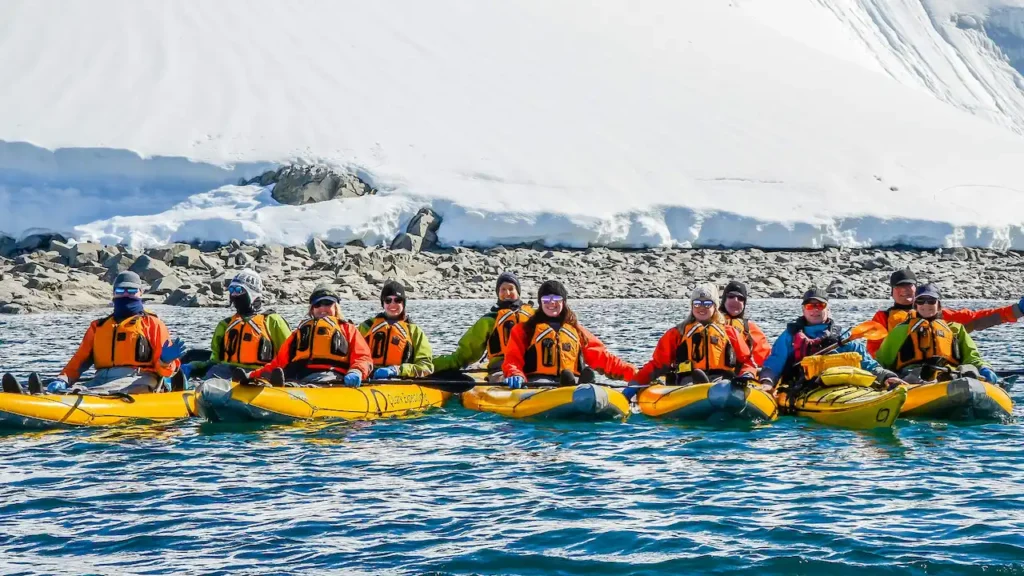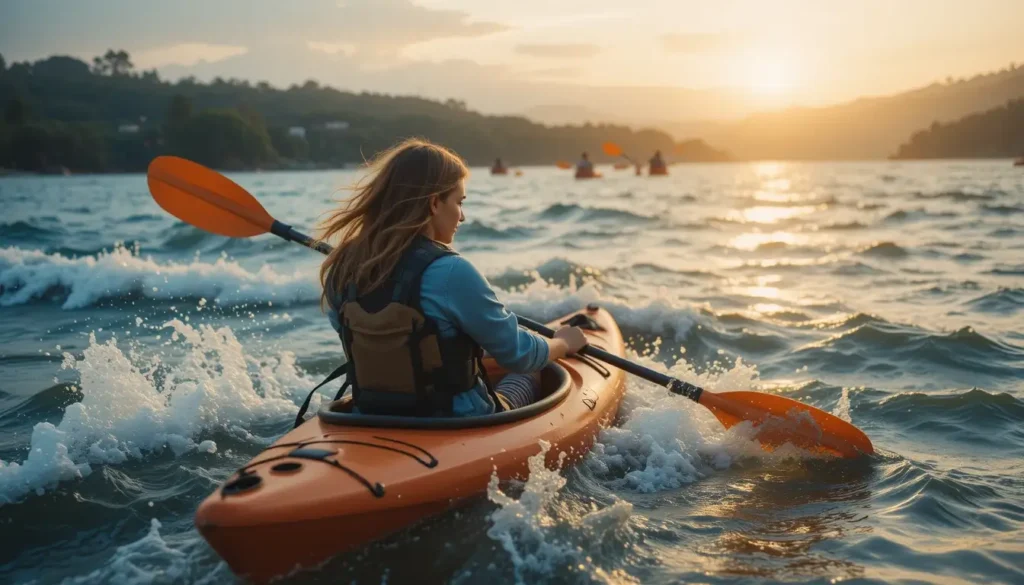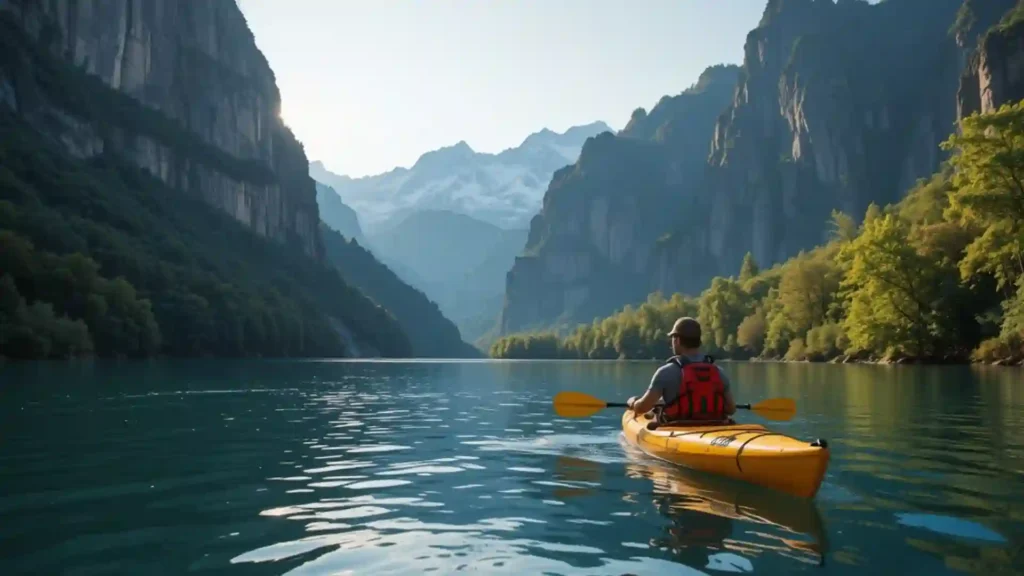The moment my kayak slips into the water, something changes. The world gets quiet. My breathing slows down. Stress doesn’t vanish—but it no longer controls me.
You’re not alone if your days feel loud and your brain feels heavy. Many people carry that weight. You might think about exercise, apps, or travel to escape. But the answer can be much closer—and much simpler.
Kayaking gives you a way out. Not a fantasy, not a break, but real relief you can feel in your body and mind. You don’t need to be an athlete. You don’t need a big plan. You just need water, a boat, and the will to try.
This isn’t about adventure. It’s about healing. About switching your brain from noise to peace. About using movement to reset, not to chase a goal. I’ll show you how it works and how to start—so the calm becomes part of your life, not just a once-a-year thing.
Why Water Changes Your Brain
Most people don’t think about what water does to them. They focus on paddling. But the water itself has power.
Water Shifts Your Senses
When you float in a kayak, your senses take in new information. Your ears hear wind and water instead of traffic or digital noise. Your eyes watch ripples, reflections, and small movements instead of fast, bright screens.
Your skin feels the temperature of the air and the splash of the water—not the hard surface of keys or the dry feel of plastic.
This shift matters. Your brain calms when it gets natural, simple input. It doesn’t have to filter out clutter. That helps you feel grounded, clear, and present.
Water Interrupts Noise from the World
Kayaking puts you in a space where digital alerts, demands, and pressure can’t follow. You won’t hear ringtones. You won’t see texts. You won’t be asked to reply or decide.
This is more than a break—it’s a pattern interruption. Your brain stops expecting stress and starts reacting to calm. It doesn’t just rest; it rewires how it handles the outside world.
The less noise you get, the more silence your brain can accept. And in that silence, stress starts to fade.
Water Slows Your Body and Brain
Gentle paddling leads to real physical changes. Your heart rate lowers. Your muscles release tightness. Your breath becomes deeper and more regular.
These aren’t guesses—they’re measurable effects seen in stress-reduction research. Being near or on water activates your parasympathetic nervous system. That’s the part of your body that calms you down after stress.
As your body shifts into this mode, your mind follows. Thoughts feel less heavy. Racing ideas slow down. You feel like you have space again.
Water Pulls You into the Present Moment
Most activities let your brain wander. You think about the past. You plan the future. That keeps stress alive.
Kayaking doesn’t allow that. You have to pay attention—to your balance, your paddle, your direction, the current. Not because it’s hard, but because your body knows it matters.
This natural focus pulls you out of worry. You stop overthinking and start observing. That’s when calm begins. You’re not frozen. You’re not distracted. You’re in motion—but peaceful.
Water Makes You Feel Safe While Moving
In a kayak, you’re held by the water but also moving through it. You’re not stuck. You’re not rushing. You’re free to glide.
This creates a special balance your brain craves: stillness and motion at the same time. You’re not under threat, but you’re not inactive either. This tricks your brain out of “fight or flight” mode.
It tells your nervous system: you’re okay. You’re moving, but not chasing or running. That’s when the healing starts.
This happens faster in a kayak than in most activities. Why? Because it forces you to sit still and focus only on the now. You’re safe, you’re moving, but you’re also surrounded by peace.
Movement That Heals, Not Hurts
Exercise can help stress, but it can also add pressure. Timers, goals, reps—those can make things worse. Kayaking is different.
Your body works, but gently. You move your arms, twist your core, and sit with posture. It feels good without feeling hard. You don’t chase speed or numbers. You just paddle when you feel ready.
That’s what makes it powerful. You’re active, but not pushed. You’re doing something, but not performing. It becomes a rhythm you fall into, not a task to finish.
This kind of movement calms your nervous system. You’re not stuck in fight-or-flight mode. You’re not in freeze. You’re flowing—and your body knows it’s safe.
Many of my best sessions on the water weren’t long or hard. They were slow, quiet, and personal. I left lighter than I arrived.
Stress is a loop. You wake up stressed, do your tasks while stressed, and go to sleep stressed. It repeats. Breaking it takes more than rest. It takes interruption.
That’s what kayaking does. It cuts the loop.
Once you’re on the water, you can’t keep checking your phone. You don’t hear your notifications. You don’t run into your boss. You stop being reachable. That single step—being unavailable—is enough to shake the cycle.
But there’s more. Your brain has to switch gears. It watches for movement. It steers. It reads the current. It listens to wind. That’s not stress. That’s awareness. And awareness kills stress.
After 20 minutes, you forget what was on your mind. After 40 minutes, you don’t want to leave. That’s when healing happens—when you feel it, not just know it.
You might not believe this until you try. But the moment your brain goes quiet, you’ll get it.
Most people think they need to travel to relax. They think peace only lives in far places. But water is closer than you think.
There are rivers, lakes, and calm coastlines in most areas. Many offer kayak rentals. Some offer lessons. Some have guided sessions made just for stress relief.
I tell new paddlers to start small. Don’t wait for vacation. Don’t aim for distance. Find a nearby body of water. Rent or borrow a kayak. Spend 30 minutes just floating. See what it does to you.
It’s not about technique at first. It’s about presence. Are you here? Can you let go? That’s the first skill—and it’s the only one you really need.
Once you feel that shift, you’ll want more. Then you can build your gear, your routes, and your habits. But that comes later. The peace comes first.
Kayaking as a Ritual, Not a One-Time Fix
Stress isn’t a one-time problem. It builds over days, weeks, or even hours. One good experience on the water helps, but it won’t erase future stress.
That’s why relief has to repeat. You need a system, not a surprise. A habit that gives your brain regular breaks—not just emergency resets.
Kayaking becomes that system. Not a fix, but a release you return to before pressure piles up.
Make Kayaking a Personal Habit, Not a Rigid Schedule
You don’t need to kayak every day. You don’t need a clock or a strict plan. Instead, listen to your body. Go when your thoughts feel crowded. Go when you haven’t taken a deep breath in hours.
Stress shows up in signals—tight shoulders, tired eyes, shallow breathing. When you notice those, that’s your cue. Your kayak becomes your tool, not your task. That’s how habits form without pressure.
Find a Rhythm That Fits Your Life
Some people paddle after a long day to release what they’ve carried. Some go early, when everything’s quiet and untouched. Others save it for weekends, when there’s more time and less rush.
There’s no right or wrong way. You don’t need permission. You only need something that works with your life.
The key is this: keep showing up. Whether it’s twice a week or once a month, make it yours.
Shape the Experience Around What You Need Most
Some days you’ll want silence. Some days a slow playlist helps you breathe. Sometimes you’ll want to be alone. Sometimes a quiet friend beside you makes it better.
There are no rules. You can paddle fast if you feel restless. You can drift if your mind feels heavy. Stay close to shore if you want comfort. Go farther if you want space.
This is your reset. Not a class. Not a race. Just peace—your way.
Let Kayaking Replace Unhealthy Coping Habits
When kayaking becomes your ritual, you stop reaching for quick fixes. You don’t scroll to escape. You don’t snack to feel comfort. You don’t binge shows just to drown things out.
You have a real option now. You get in your boat. You let the water do the work. It becomes natural. Automatic. Your brain starts to calm before you paddle—because it remembers what comes next.
This is how lasting change begins. Not by force. But by choosing peace again and again.
You can’t live on the water. But the peace doesn’t have to stay there.
Once you’ve felt what stillness does to your brain, you’ll find ways to return to it. You’ll breathe differently. You’ll walk slower. You’ll notice more.
That’s the real win. Not the paddle, not the boat—but the quiet you carry into the rest of your life.
I’ve kayaked for years. I’ve trained hard, raced fast, and explored wild places. But nothing compares to the calm I find in a short, solo paddle near home.
You can have that too. No need to prove anything. No need to wait. Get on the water—and let your stress lose its grip.
Let this be your first paddle into peace. You won’t forget it. And you won’t want to stop.




